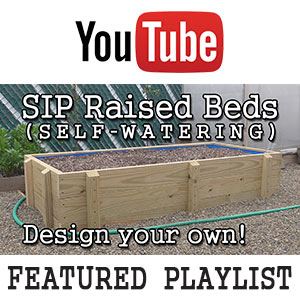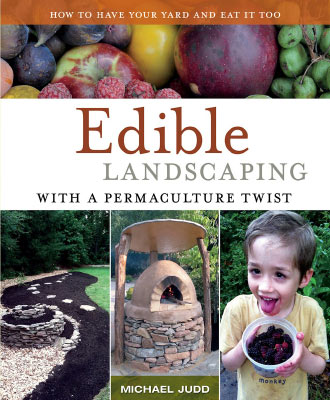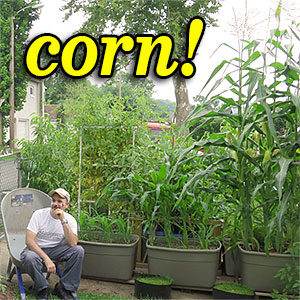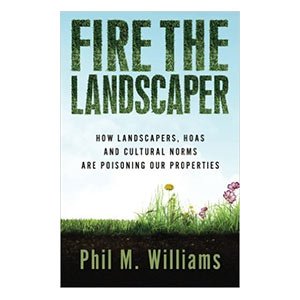Weed Suppression:
Landscape Fabric vs Cardboard?
I was working at a site that had been overrun by weeds. They completely invaded the landscape beds. And yet, those very beds had a weed suppressing landscape fabric installed. Seeing the absolute mess and the management strategies that led to it has motivated me to share some pros & cons about the use of landscape fabric.
Should you use landscape fabric? What causes it to fail? Are there any alternatives to a synthetic weed barrier? What should be considered as a long term solution?
Landscape or weed fabrics create an impassible barrier that stops the upwards growth of plants from underneath. So the soft stems and leaves get trapped beneath. When used in a home landscape though, an application of mulch is commonly placed on top. The mulch holds the fabric in place, blocks out the sunlight and further suppresses growth. Aesthetically, it looks nice. And as a short term solution for reclaiming a weedy bed, the fabric can help out.
- Pros & Cons of Landscape Fabric
- When Landscape Fabrics Make Sense
- Is Rubber Mulch Good?
- Disadvantages of Landscape Fabric
- Using Cardboard Instead of Fabric:
- Cardboard: a Biodegradable Alternative
- How to Kill a Large Area of Weeds Naturally
- How to Apply Cardboard: Tips for Success
- Long Term Strategy for Weed Control
- Cardboard Safety Concerns:
- Is Cardboard Safe for the Garden?
- What About Termites? How to Protect Your Home
When Landscape Fabrics Make Sense:
NON-BIODEGRADABLE MULCHES: By its very design, landscape fabric is intended to last for a long time. It is made from non-degradable, synthetic fibers. So it works best when paired with mulches that will hold up just as well. Rubber mulches*, river rock or other stones. These materials won't decompose and turn into soil. But they WILL start to sink down into the dirt of your bed.
By adding a non-degrading layer to separate the soil from the stones or rubber mulches, you can set up a system that will last for quite some time. It's not my personal approach to landscaping, but when used in this way, landscape fabric makes sense. It serves the same role as sheets of plastic would. But fabric at least has the added advantage of water permeability. Some of the rain falling onto your bed will penetrate and sink down into the ground. In contrast, a plastic barrier results in complete run off of precipitation.
Of course, you need to keep the beds free from debris such as leaves. Failure to do so will result in the slow break down of organic matter which creates a soil in between the crevices of your mulches. Weed seeds blow in. And you have a weed infested mess. Once weeds start growing over top of landscape fabric, they can be quite hard to pull out. Often the root hairs penetrate the fabric and get deeply embedded.
RHIZOME CONTAINMENT: Once organic matter piles on top of landscape fabric, plants can easily start to grow on top. But the fabric does continue to work fairly well at suppressing growth from below. So landscape fabric could be a great way to maintain the boundaries around plants that produce rhizomes or underground stems. For example, if you want to stop raspberries from popping up into an adjacent walkway, a layer of fabric can do the trip. Typically, emerging shoots are too thick to penetrate and they simply get deflected back down, below the fabric.
Is Rubber Mulch Good?
* RUBBER MULCHES: I strongly advise against this material in most landscape and gardening situations. It's important to understand what you're getting when you apply rubber mulch. You're getting shredded up pieces of car tires. When your tires lose their tread, you pay a disposal fee. Then you drive to Lowes or Home Depot and pay money for a bag containing some else's shredded tires. Most of us don't want old tires laying around our properties. But with rubber mulch we end up spreading them all over our landscape (minus the metal wires).
On the other hand, the idea of recycling tires is a good thing. It's better to keep tires out of landfills by converting them into a usable product. Recycled tires can serve a valuable function when used in the right way. Synthetic turf often contains recycled tire crumb rubber. It holds up well and eliminates the maintenance costs associated with grass turf. Recycled tires can also be made into rubber paver tiles. I've applied these along my sidewalk, in place of grass, cutting down on maintenance time. Rubber mulches might make sense in well constrained playground areas where nothing is being grown or cultivated.
But why not use it everywhere, even in the landscape? Isn't rubber mulch advantageous since it lasts a long time? Indeed, that might make it appealing. But that's more of a drawback than a benefit. Rubber pieces can be lightweight and small enough to blow around in strong winds. They can get washed out in heavy rains. Admittedly, wood mulches have this same issue. But wood is naturally biodegradable and will break down, enhancing your soil. If pieces find their way onto your neighbor's property, it's not a big deal. Just like tree leaves or grass clippings, it can all biodegrade.

Old tires are shredded into mulch for beds, only to find their way onto the sidewalk and street.
DRAWBACKS OF RUBBER MULCH: Unfortunately, rubber does not break down. It will always be there, becoming a liability, even after you've finally decided you don't want it anymore. You can't just mulch over top of it if you decide you want a new look for your beds. Over time it will mix with organic material, making it nearly impossible to entirely remove. Essentially, you've just turned your yard into a landfill.
Worst of all, rubber mulches are highly flammable, often much more so than wood. A Consumer Reports test found that "rubber mulches burned faster and hotter, creating a more severe fire that was harder to put out than the one in the wood mulch." A study from University of Nevada measured higher flame heights and hotter burn temperatures with shredded rubber vs wood products. Although, shredded western red cedar had a faster rate of spread, pine bark nuggets had a very low rate of fire spread. The safest of all was composted wood chips. This is important to know considering the rise in wildfires across our globe. Rubber mulches just make things worse, increasing risk to homes in wildfire prone areas.
Disadvantages of Landscape Fabric:
Synthetic weed barriers can accomplish a task, but they're no silver bullet. When paired with the wrong mulch material, their limitations might not become apparent until a year or two has passed. But before long, you may start to see that your beds are just as weedy as they were before, especially if they've been neglected.

Due to the way it was applied, this landscape fabric was not able to stop fresh weed seeds from growing.
In many residences, wood based mulches are customarily applied on top of fabric. But the biodegradable nature of wood causes the mulch to slowly break down, forming a layer of soil. That upper layer can be a perfect rooting medium for fresh weed seeds that find their way into your beds. Before you know it, you've circumvented your weed barrier and weeds just grow right on top of it!
All the while the microbial processes that rejuvenate your soil are being hindered by this synthetic, barrier. Earthworms and various arthropods cannot freely pass from below the soil up to the surface.
Your perennial plants become girdled as they grow wider and wider. Clumping and rhizomatous plants get trapped underneath. And creeping or layering plants cannot properly root as their roots get entangled in the fabric.
Video: Landscape Fabric Finding an Alternative
I've been able to reclaim weedy and grass filled beds using cardboard as sheet mulch.Cardboard: a Biodegradable Alternative
A free, biodegradable alternative to landscape fabric is to use simple old cardboard. The idea is derived from the concept of sheet mulching. In permaculture, sheet mulching can be done to reclaim an area of land that might have been weedy or even covered with grass.
NOTE: Technically 'cardboard' is not the same as 'corrugated fiberboard'. Corrugated fiberboard has several layers sandwiched together which may include cardboard. But both materials can be used in this application and people often refer to both materials simply as "cardboard". So be aware that these can vary greatly in their thickness and number of layers.
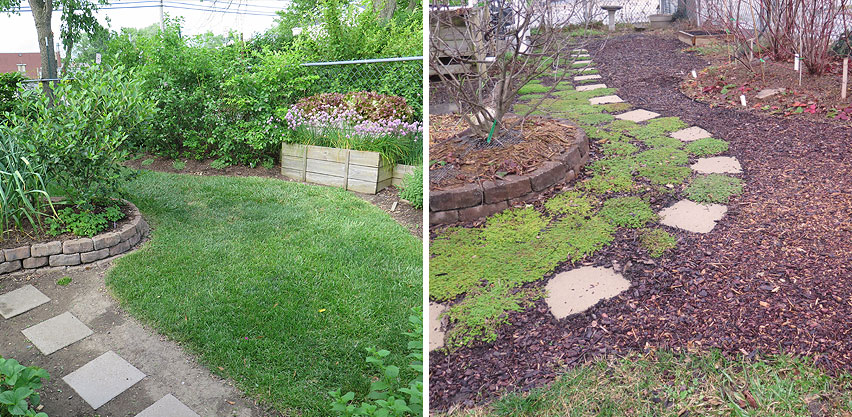
I was able to eliminate most of my grass lawn without using chemicals by applying cardboard covered by wood mulch.
How to Kill a Large Area of Weeds Naturally
Using cardboard or newspaper as a natural weed barrier can allow you to kill a very large area of weeds and grass without using any chemicals or herbicides. Cardboard is applied to the area. Then a layer of mulch goes on top of that. In creating a highly fertile site, a gardener may put several layers of materials. Leaves, compost, grass clippings, straw, etc. But in more conventional landscape applications, it would certainly work to just put a wood based mulch right on top of a couple layers of cardboard.
Most weeds or grasses are unable to pass up through the cardboard. By adding wood mulch on top, you can effectively smother these unwanted plants, making way for new plantings. It's a great way to reclaim the bed and get a fresh start. Meanwhile, that cardboard breaks down and is eaten up by earthworms. Ultimately, it won't interfere with biological processes.
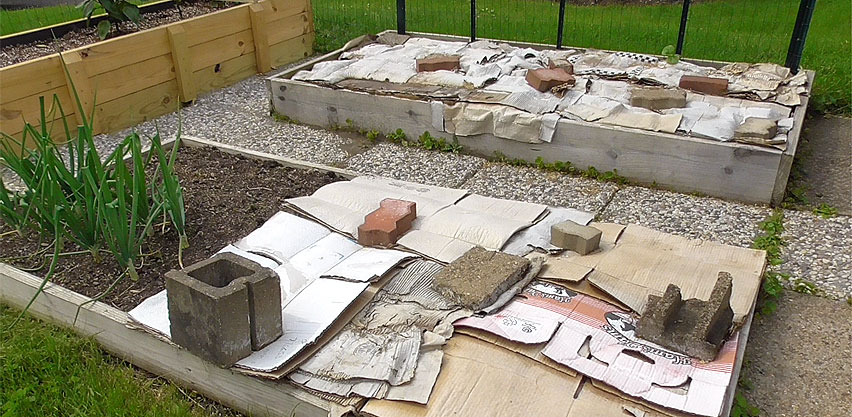
Cardboard sheets can be used on garden beds as weed suppression during the off-season. Just remove them at planting time.
HOW LONG DOES IT LAST? This process is a temporary solution, not a permanent fix. The big advantage to cardboard is that it doesn't stay there forever, getting locked up in soil layers. I've seen the cardboard disintegrate after 6 months. But in other spots it's still been there a year later.
Several factors impact the decay rate. How thick is the cardboard? How many layers did you use? How thick was the top mulch layer? Is your area arid, or do you get a lot of precipitation? Dry cardboard may just sit there, lasting a long time. If it stays moist most of the time, it will break down much faster. Try to consider these factors when deciding if it's a good fit for you!
How to Apply Cardboard: Tips for Success
PAIR IT WITH THE RIGHT MULCH: If you want to work with a wooden mulch, then cardboard is a great option. But it isn't a good barrier for use under stones or rubber mulches. It would work for initial suppression. But afterwards, the cardboard would decompose while the mulches would remain intact, slowly sinking into the dirt of your bed.
USE A THICK LAYER: Some people mention using newspaper as an option. It's a great way to manage weeds on your regular garden beds. To suppress a weedy or grassy patch, you would need multiple layers and a substantial mulch application placed on top. I prefer cardboard in landscape beds, using 2 layers (standard thickness). A single layer should work well if it's extra thick.
CARDBOARD PREP: Look for non-glossy cardboard that has a minimal amount of ink imprint. Select the largest pieces you can possibly get. Local businesses might allow you to dumpster dive for their cardboard. But I seem to always have some from various online orders. Pull off any staples, tape or stickers, since these won't decompose. Well established, vigorous plants may send their stems along the bottom, seeking an edge or a hole in your barrier. So when you need to use multiple layers, be sure to generously overlap the seams. It's also a good idea to pull out or dig up weeds that are at the very edge of the bed.
IT'S NOT BULLET PROOF: Worms enjoy soft, decomposing cardboard. Birds enjoy worms. So be aware that you may have animals perforating your sheet mulch layer. This might require weeding out any plants that find their way to the light. Besides pulling out those weedy culprits, you can always apply a quick patch. Just pull away the mulch and drop down a fresh layer of cardboard.
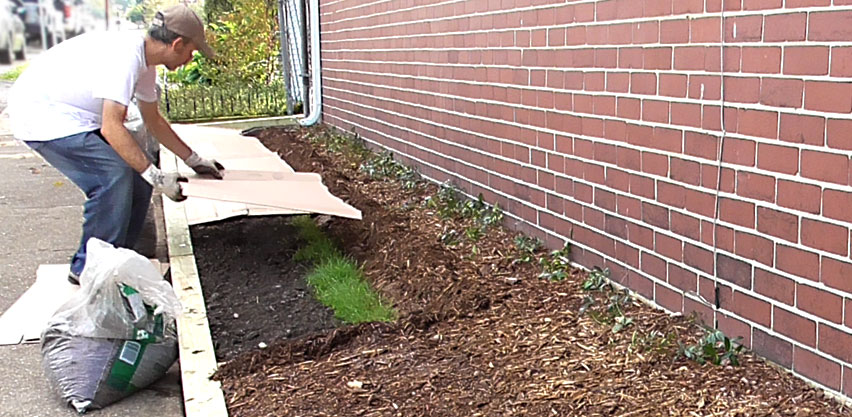
I was able to eliminate this strip of grass lawn by covering it with cardboard & wood mulch.
Long Term Strategy for Weed Control
Are you looking for a way to reduce mulching requirements? How can you keep out weeds? Nature abhors a vacuum. So your final landscape or garden should be designed in a way that fills those large empty spaces.
Plan out multiple layers of trees, bushes, shrubs and herbal plants. Allow these to fill in your beds, choking out any weeds that make their way into your property. To cover large areas of ground, without relying on grass, consider using ground covers.
READ MORE: Ground Cover Perennials for Weed Control →

Cardboard & mulch eradicated a huge strip of weeds. Now it's a planter of herbs & groundcovers that crowd out new weeds.
Is Cardboard Safe for the Garden?
SHOULD YOU WORRY ABOUT FORMALDEHYDE IN CARDBOARD? People might assume that failure to decompose is direct proof that cardboard is full of formaldehyde. Firstly, we need to be much more concerned about its persistence in the air of our homes. If my cardboard actually did have formaldehyde in it, then I would want it OUT of my house. I'll gladly place it outdoors where it can off-gas! But secondly, and more importantly, try researching the chemical itself. How does the compound react in the environment? The Canadian Environmental Protection Act, 1999 (page 49) states: "Given its physical-chemical properties, formaldehyde is degraded by various processes in air, with very small amounts transferring into water. When released to water or soil, formaldehyde is expected to remain primarily in the original compartment of release, where it undergoes various biological and physical degradation processes. Formaldehyde is not bioaccumulative or persistent in any compartment of the environment."
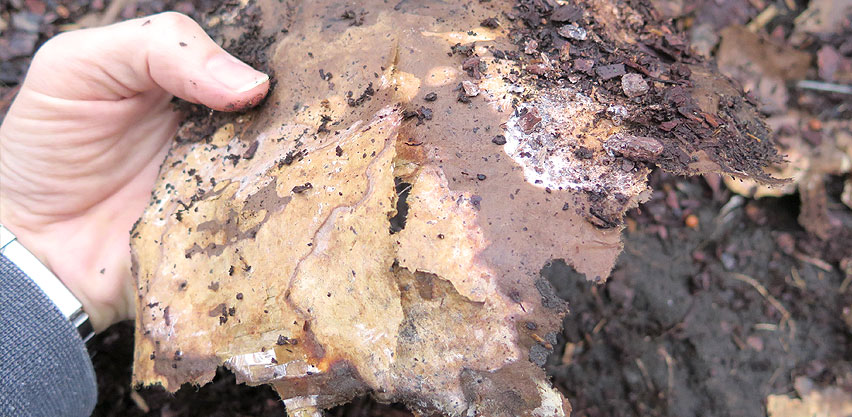
This cardboard has broken down after just 6 months. You can see white mycelium from fungal degradation.
BUT WHY ISN'T THE CARDBOARD DECOMPOSING? Perhaps your cardboard has stuck around longer than expected. Even still, don't assume that a few poorly decomposed cardboard sheets indicate a highly concentrated level of formaldehyde that has stalled all biological activity. That's completely baseless. As pointed out by the ATSDR, "Low levels of formaldehyde occur naturally in a variety of foods, such as fruits." So should we stop composting old fruit for fear that we'll disrupt the ecosystem? Rather than blaming formaldehyde as the reason cardboard isn't naturally disintegrating after being installed, the more likely culprit is lack of moisture. If the cardboard was installed in a dry environment where it gets very little water exposure, then it can persist for a long time without decomposing. That's why I always cover mine with a generous layer of mulch and trample it into the ground, removing air gaps.
READ MORE: Growing Mushrooms to Break Down Cellulose →
DOES CARDBOARD CONTAIN TOXIC HEAVY METALS? Another issue with using cardboard in the garden is heavy metal contamination. Heavy metal exposure primarily results from paints, pigments and other colorants used in printing processes. The primary metals of concern are lead, cadmium, nickel, zinc and copper. As it turns out, nickel, copper and zinc are all micronutrients which plants directly use for biological functions. But lead and cadmium exposure is more concerning. When researchers tested multiple samples of recycled paper (the kind used in cardboard) they found very low, but detectable levels of lead and cadmium. For lead, the mean value was only 2.6 mg/kg which is 2.6 ppm by weight. For cadmium it was 0.094 mg/kg which is very low and well within safety standards.
So although some trace amounts of heavy metals can be detected in cardboard products, there is no reason for alarm. In a general landscape setting, the small amount of cardboard applied in sheet mulching shouldn't cause any issues. And it would even be safe enough to use in a vegetable garden. To play it safe, you can simply opt for uncoated, unprinted cardboard pieces. Since the heavy metals are derived mostly from inks, this is the safest way to use cardboard in your beds.
What About Termites?
How to Protect Your Home
It's worth noting that cardboard is composed of cellulose. Thus, as with any other wood based product, it can serve as a food source for termites. If you have an issue with termites on your property then you might prefer to avoid making things worse by laying down cardboard. However, if this is the case, then there is more to do than simply avoid cardboard.
THINGS TO AVOID: To reduce feeding sources for termites, it's best to avoid all wood mulches and chips. That includes ones that might seem to be termite resistant like cypress or cedar. Eventually, the protective compounds in the wood will leach away and termites might feed on the wood particles.
Do not allow any wood to be in contact with the ground. Think about stacks of firewood. What about wooden boards used for raised beds? Even treated wood becomes vulnerable over time. Obviously you would not create any hügelkultur mounds which are comprised of logs that are buried under layers of soil.
CONSIDER THE SOURCE: In reality, termites serve a vital function in our ecosystems. Once a tree or woody shrub dies, termite colonies move in to break down the massive networks of buried roots. So if you are afraid of attracting termites to your property, then you might think twice about cutting down any trees or large shrubs on your lot. That is where the real termite invitation comes into play. A single medium tree will have deposited much more cellulose under ground than those few sheets of cardboard that you are contemplating.
PROTECT YOUR HOME: Perhaps you've cut down trees, applied wooden mulch or placed sources of cellulose throughout your property. Even still, there are certain basics that can be done to protect your structures from termite invasion. Essentially, you want to avoid creating any bridge from the outside soil to your home.
Subterranean termites feed on the extensive network of roots from dead trees. They will follow the path of wood or moist soil in search of food. So your buildings need to be surrounded by a buffer, a barrier of dry, uninviting soil. Make sure your ground is properly graded, sloping away from the base of your structures. Gutters and downspouts should be moving rainwater away from the foundation so that it is kept dry.
Don't lay cardboard along the surrounding perimeter. But don't use landscape fabric or plastic either. The soil should be kept bone dry to inhibit the migration of termites. That means no wooden mulch or chips, but also no rubber mulch or stones. Keep all of these things 12 inches away from your buildings so that there is only exposed, dry soil.
SOURCE: Subterranean Termites - a Handbook for Homeowners

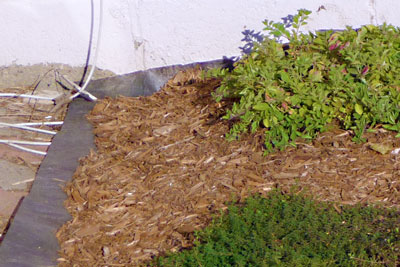
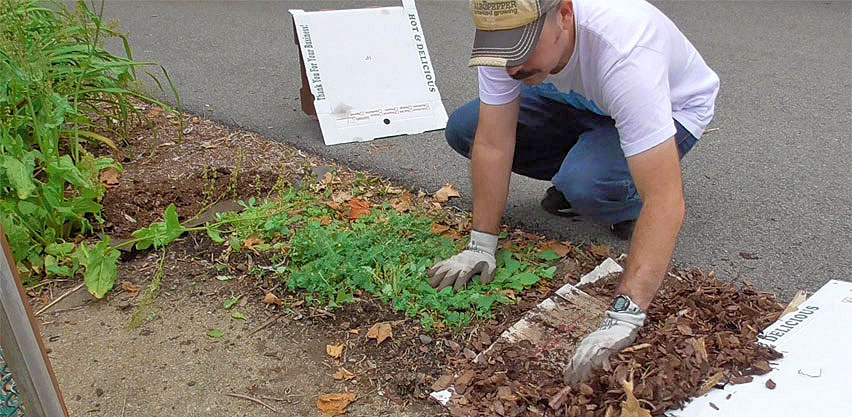

![Long Live PERENNIALS! [Gardening T-Shirt Design] Long Live PERENNIALS! [Gardening T-Shirt Design]](images/Long-Live-PERENNIALS-Gardening-T-Shirt-th.jpg)

